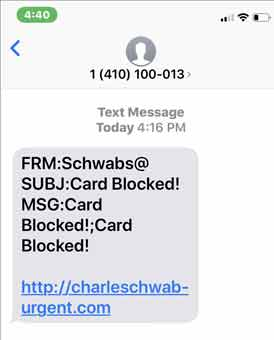‘Smishing’ Scam on the Rise


While you’re likely familiar with the term ‘phishing’, have you heard of the term ‘smishing’? Smishing refers to a phishing attempt initiated via text message. In a smishing scam, individuals receive a fraudulent text message from what appears to be a legitimate source (such as a bank) to lure someone into sharing their account credentials or other personal information. This type of scam has become increasingly popular, and we’ve learned that there is a current smishing scam pretending to be Schwab Bank.
As seen in the screenshot below, individuals are being led to believe that their Schwab card has been blocked, and they are being directed to a link to take action. The link directs users to a fake website requesting they enter their account credentials which fraudsters can then use to gain access to their funds. Please know that these communications are NOT from Schwab, and they are working diligently to have all linked websites shut down immediately.

To keep your identity and information safe in this smishing scam or otherwise, please keep in mind the following best practices:
- Do not click links or provide any personal information to a sender that looks unusual.
- If you have received a fraudulent text and have NOT acted on it, you may safely ignore the text and delete it.
- If you have clicked on or supplied any credentials via a potentially suspicious link, it is highly encouraged that you immediately change your login and password information for that account and any associated email accounts.
- If you are ever unsure of the legitimacy of a link or website sent to you via text, email, or otherwise, navigate directly to the provider’s website using a browser or authorized mobile app instead of clicking on a hyperlink.
For more tips on protecting yourself from fraud, check out these resources and as always, please don’t hesitate to contact us with any questions.
RESOURCES:
